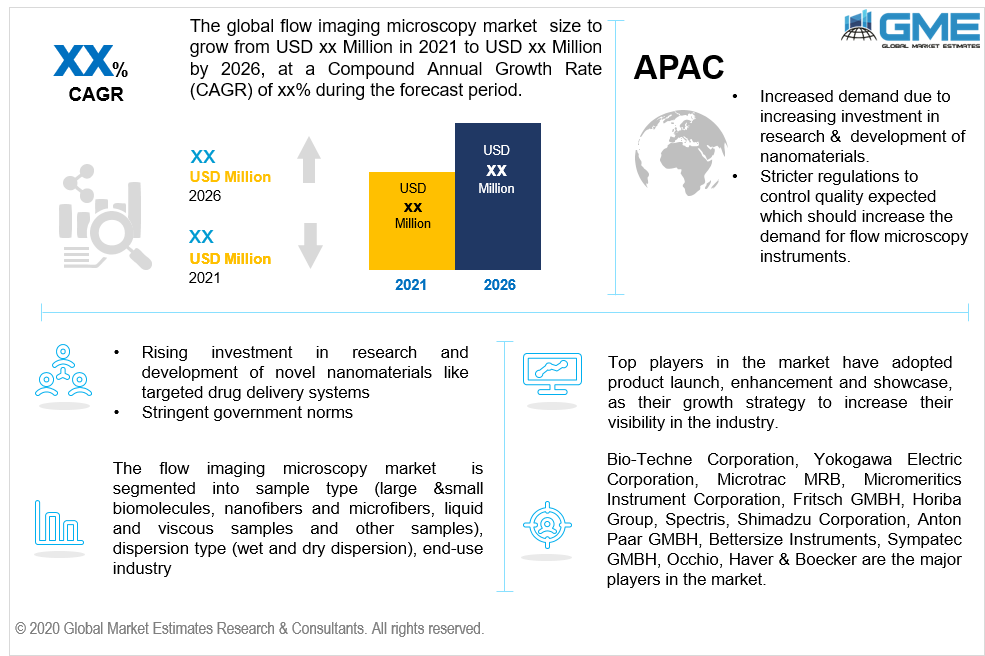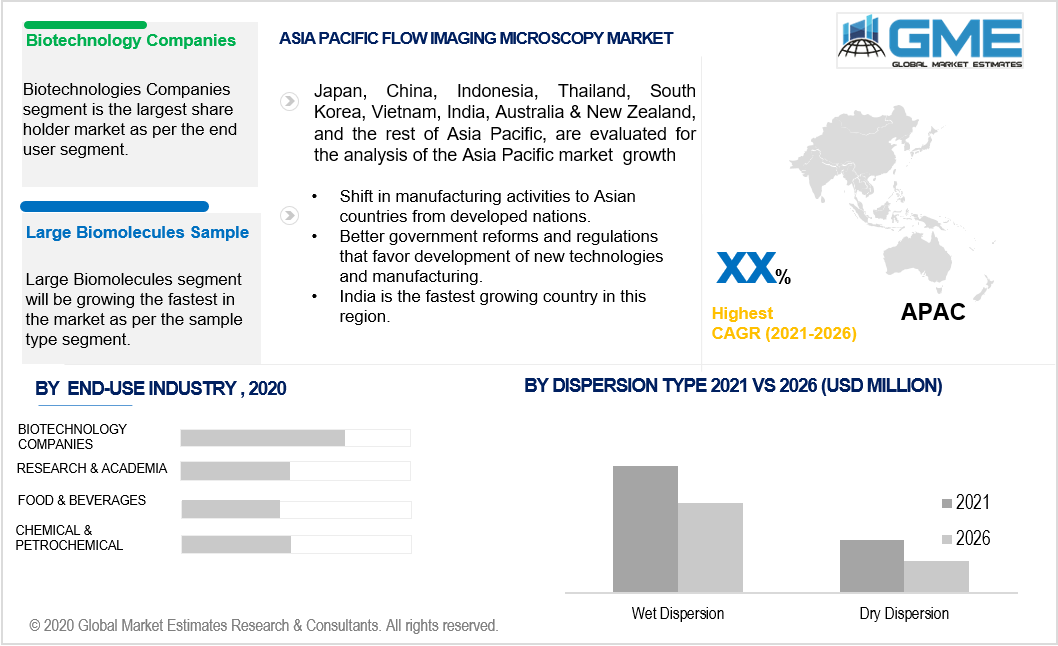
Global Flow Imaging Microscopy Market Size, Trends & Analysis - Forecasts to 2026 By Sample Type (Large Biomolecules, Small Biomolecules, Liquid & Viscous Samples, Microfibers & Nanofibers, and Other Samples), By Sample Dispersion (Wet Dispersion & Dry Dispersion), By End User (Biotechnology Companies, Pharmaceutical Companies, Research & Academia, Food & Beverage Industries, Chemical & Petrochemical Industries, Water Testing Laboratories, and Metal Manufacturers) By Region (North America, Europe, Asia Pacific, MEA, and CSA); End-User Landscape, Vendor Landscape, and Company Market Share Analysis & Competitor Analysis
Flow imaging microscopy or dynamic imaging is used to study the size distribution, roughness, shape, symmetry, and color of particles within samples that cannot be visualized with the human eye. This method is largely used in the study of novel micro and nanomaterials, especially in the biotechnology field. Imaging of particles is an important analytical tool to researchers and industries that invest heavily in the development of micro and nanomaterials. This has resulted in an increasing need for faster, more efficient, and dynamic imaging techniques which has resulted in the growth of the flow imaging microscopy market. New materials especially biomaterials are subject to stringent laws and regulations by the concerned authorities in every country or region. This has also been a driving factor in the growth of the flow imaging market.

Based on the type of sample, the market is segmented into liquid & viscous samples, micro & nanofibers, large & small biomolecules, and other samples. The large biomolecules segment will be the largest one, as it consists of carbohydrates, lipids, proteins, and nucleic acids which are the fundamental building blocks of biomaterials. Given the invasive nature of novel biomolecules, they are susceptible to heavier scrutiny from governments which has increased the need for an extensive study of these molecules through flow imaging microscopy.
As samples are dispersed differently based on their unique characteristics and requirements the market can be segmented into wet and dry dispersed samples. Biotechnology and pharmaceutical samples are largely dispersed within a liquid medium. Along with the rise in the use of nanotechnology in the food and beverage industries, the wet dispersion segment holds the largest share of the market.
Based on the end-user, the market can be segmented into biotechnology companies, pharmaceutical companies, research & academia, food & beverage industries, chemical & petrochemical industries, water testing laboratories, and metal manufacturers. Biotechnology companies hold the largest market share as of 2020. With the rising advancement in technology, the research and development of new treatments with novel biomaterials are on the rise. The increasing public and private funding in biotechnology companies have led to heavier demand for flow Imaging techniques within this industry.

The North American region holds the largest market share while the Asia Pacific region will have the highest CAGR for the forecast period (2021-2026). Heavy investment in healthcare and stricter laws and regulations on pharmaceuticals, biomaterials, and food & beverage industries are the major driving factors for the North American market. APAC region holds a lot of potential as investments in novel bio nanomaterials are on the rise, with more stringent regulations expected to be placed on these materials to ensure quality. There has also been a gradual shift in the manufacturing of pharmaceutical products from developed nations to Asian countries. Hence, the APAC market is slowly emerging as a major player in the growth of the flow imaging microscopy market.
The major players of the global flow imaging microscopy market include Bio-Techne Corporation, Yokogawa Electric Corporation, Microtrac MRB, Micromeritics Instrument Corporation, Fritsch GMBH, Horiba Group, Spectris, Shimadzu Corporation, Anton Paar GMBH, Bettersize Instruments, Sympatec GMBH, Occhio, Haver & Boecker among others.
Please note: This is not an exhaustive list of companies profiled in the report.
At the JP Morgan Healthcare Conference 2021, Bio-Techne (US) announced that it's on a trajectory to reach USD 1.5 Billion in 2025, double of its 2020 figure of USD 739 Million.
We value your investment and offer free customization with every report to fulfil your exact research needs.
The Global Flow Imaging Microscopy Market has been studied from the year 2019 till 2026. However, the CAGR provided in the report is from the year 2021 to 2026. The research methodology involved three stages: Desk research, Primary research, and Analysis & Output from the entire research process.

The desk research involved a robust background study which meant referring to paid and unpaid databases to understand the market dynamics; mapping contracts from press releases; identifying the key players in the market, studying their product portfolio, competition level, annual reports/SEC filings & investor presentations; and learning the demand and supply side analysis for the Flow Imaging Microscopy Market.

The primary research activity included telephonic conversations with more than 50 tier 1 industry consultants, distributors, and end-use product manufacturers.

Finally, based on the above thorough research process, an in-depth analysis was carried out considering the following aspects: market attractiveness, current & future market trends, market share analysis, SWOT analysis of the companies and customer analytics.

Tailor made solutions just for you
80% of our clients seek made-to-order reports. How do you want us to tailor yours?
OUR CLIENTS